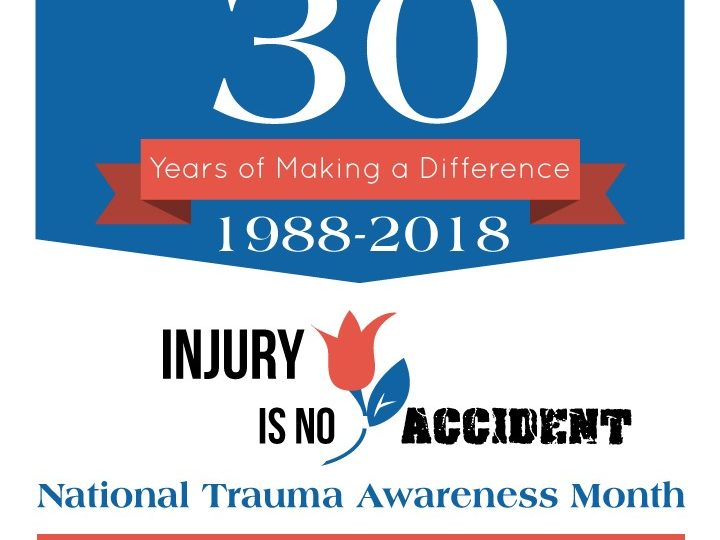May marks the 30th Anniversary for National Trauma Awareness Month. The American Trauma Society (ATS) and Society of Trauma Nurses (STN) have collaborated this year to celebrate the 30th anniversary with the theme “Injury is No Accident”.
The ATS and STN selected Personal Recreational Vehicle Safety: Safety at Any Speed as the primary focus for the 2018 awareness event – providing safety information for the following recreational vehicles: Jet Skis, Golf Carts, Snowmobiles, Dirt Bikes and ATVs.
Some basic injury prevention tips that apply to all of these recreational vehicle types are:
- Stay alert and aware of your surroundings.
- Avoid drinking/using drugs.
- Use the vehicle as it was intended to be used.

The ATS and STN have prepared a more in depth review of Personal Recreational Vehicle Safety tips for each of the above mentioned recreational vehicles:
Jet Ski Safety – As we approach the summer, this can be a fun activity enjoyed across the country, however, jet ski accidents are responsible for 26% of all registered marine vessel accidents in the United States. Follow the tips below for staying safe while having fun and don’t forget the sunblock!
- Know how to operate your jet ski – click here for free online boating courses by State.
- A jet ski will continue to travel in the same direction even when turned off.
- Use a life jacket even if you know how to swim.
- Attach the cut off key to your wrist/life jacket.
- Avoid passing too closely to other vehicles, splashing people, or jumping wakes.
- Know your swimming abilities.
Golf Cart Safety – although this is thought to be uncommon, according to Kristopher Seluga (Tampa Bay Tribune, 2012), someone dies every week from falling out of a golf cart and according to Watson, et al. (2008) hospitalization from golf cart mishaps occurs in almost 8% of total injuries with the most common cause of injury, falling from the golf cart. Even more surprisingly, 1/3 of golf cart injuries occur to children. How can golf carts be so unsafe?
- Golf carts do not have brakes on all 4 wheels, contributing to loss of control and rollovers.
- Golf carts often weigh up to 1000 pounds.
- Golf carts are not equipped with seatbelts.
- Golf carts are only meant for golf course speeds of up to 10 mph.
Ways to stay safe include having a valid driver’s license, obeying all traffic rules, remain seated when in motion, do not double up on seating, approach corners with caution and slower speeds, do not leave keys in the golf cart unattended, when not in use, place the control lever in park or neutral and always set the parking brake.
Snowmobile Safety – Snowmobiles can weigh as much as 600 pounds and travel at speeds exceeding 90 mph. According to the ATS, snowmobile accidents are responsible for approximately 200 deaths and 14,000 injuries each year. Here are some tips to keep you and your loved ones safe.
- Many states require a snowmobile certificate – check your state’s regulations.
- Check the weather forecast and trail conditions ahead of time. Delay the fun if the weather is predicting a blizzard with white out conditions, if the trail is froze, or if the wind chill is too low.
- Wear appropriate clothing and protective gear.
- Inspect the vehicle prior to riding. Be sure to check fuel levels, battery, brakes, etc. Also, be sure to let the snowmobile warm up prior to taking off.
- Ride in pairs or groups. Also let someone know your plans and route in case you get stranded.
- Carry a first aid kit, an emergency kit, and a repair kit.
- Stay alert when driving. Look for obstacles in the path, ditches, snow banks, and other drivers/skiers/hikers/animals.
- Avoid frozen rivers/lakes, etc.
Dirt Bike Safety – According to the ATS, the most current information regarding dirt bike safety was collected by the CDC in 2004. Over 88% of dirt bike accidents were male patients and over 70% of accidents were in a natural setting. Some ways to stay safe while enjoying dirt biking are listed below.
- Wear a DOT helmet and protective safety gear.
- Never ride on paved surfaces (unless using a dual-purpose model).
- Never ride under the influence of alcohol or drugs.
- Supervise riders younger than 16.
- Use the appropriate size dirt bike (i.e. speed, height and capabilities).
- Don’t ride alone or on remote trails.
ATV Safety – The ATS provided data from the Consumer Product Safety Commission from 2016, which reported 337 ATV related fatalities and approximately 101,200 ATV related emergency department treated injuries in the United States where approximately 26% of these injuries involved children under the age of 16. See below for tips on staying safe:
- Wear a DOT helmet and protective safety gear.
- Never ride on paved surfaces (unless using a dual-purpose model).
- Never ride under the influence of alcohol or drugs.
- Never carry a passenger on a single rider ATV.
- Ride an ATV that’s right for your size.
- Supervise riders younger than 16.
- Ride only on a designated trail and at safe speeds.
If you own or use one or more of these recreational vehicles, click here for additional resources that will help keep you safe. Here you will find additional safety documents, how-to documents, training and education programs, videos, inspection checklists, links to various state laws, etc. Be smart. Educate yourself on safety and injury prevention. Drive responsibly … it could save a life!










